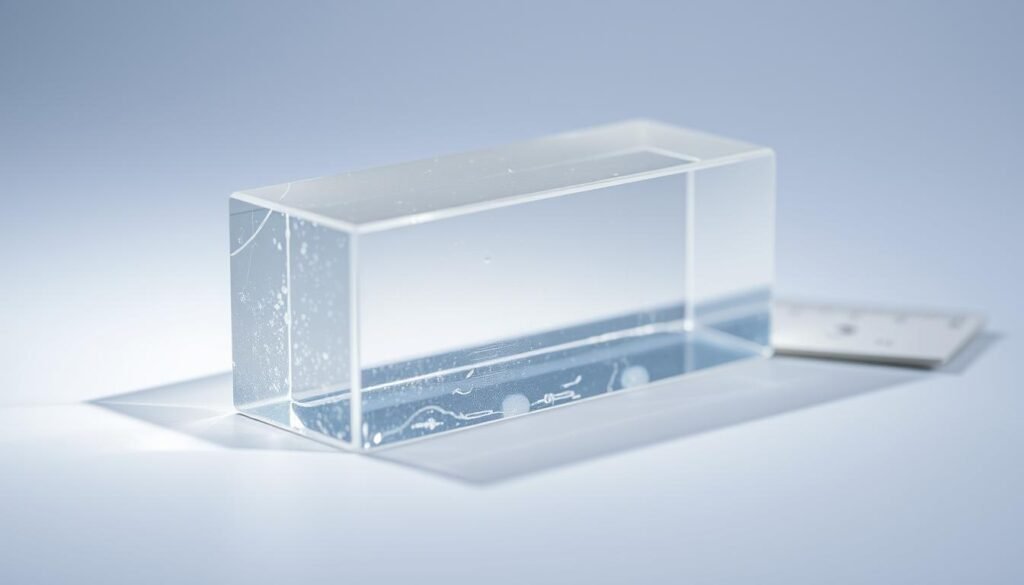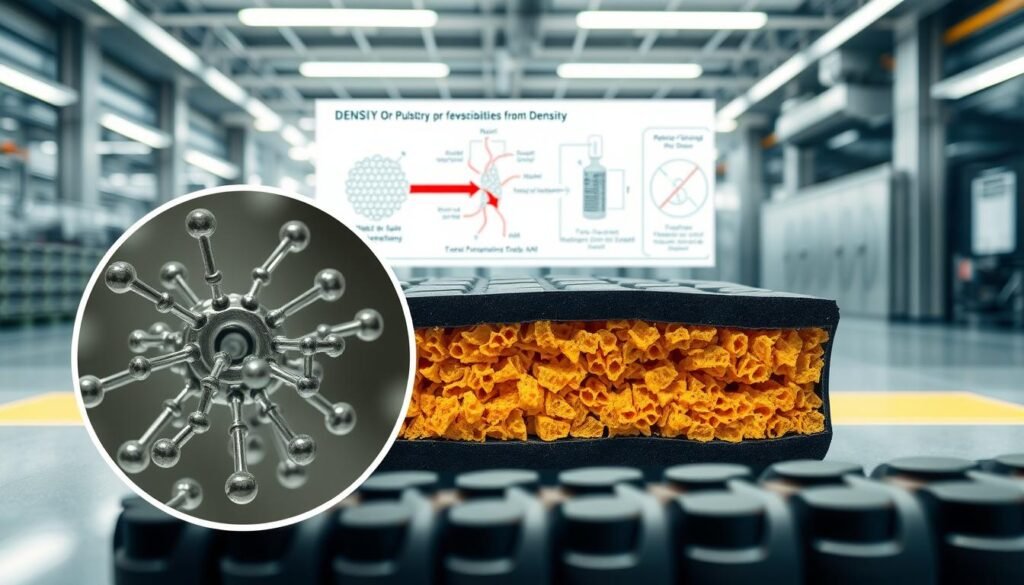The density of rubber is key to its performance and use in many industries. It’s measured in grams per cubic centimeter (g/cm³). Knowing this helps engineers and manufacturers make the best rubber for their projects.
This article will look at how rubber density is measured. We’ll explore what affects it and the differences between types of rubber. We’ll also talk about new ways of making rubber and China’s big role in the global market.
Introduction to Rubber Density
Knowing about rubber density is key in many industries. It tells us how well rubber works in different situations. The density of rubber affects its strength, flexibility, and how well it fits certain jobs.
Many things can change how rubber behaves, like what it’s made of and how it’s made. Natural rubber is lighter than many man-made kinds. This shows why picking the right rubber is so important.
Different rubbers have different densities. This info helps makers and designers make better choices. It ensures the rubber fits the job right. For more on rubber density, check out this guide.
Importance of Rubber Density in Industries
Rubber density is key in many industries. It affects how things are made, checked for quality, and how well they work. The auto, aerospace, and healthcare fields all use rubber parts. These parts need the right density to perform well.
The rubber density importance shows in its effect on things like stretchiness, lasting power, and soaking up energy. Different rubbers, like silicone or neoprene, have different densities. This affects where they can be used. For example, denser rubber sheets last longer and are better for tough jobs.
Knowing about rubber density helps makers choose the best materials. This choice improves product quality and saves money. Companies that understand this can make their work more efficient. They can also make products that are more reliable in many industrial rubber applications.
Understanding Rubber Density
Rubber density is key to understanding rubber materials. It shows how much rubber is in a given space. This is usually measured in grams per cubic centimeter (g/cm³) or kilograms per cubic meter (kg/m³). Knowing this is important for industries that use rubber.
Definition and Measurement
Measuring rubber density is critical for quality control. There are several ways to do this, like the balance method and pycnometry. The density can change based on the rubber’s type and additives. So, it’s vital to measure and understand rubber density accurately.
Units of Measurement
The standard units for rubber density are grams per cubic centimeter (g/cm³) and kilograms per cubic meter (kg/m³). These units help professionals in the rubber industry compare and analyze. The choice of unit affects how density is reported and used.

Factors Affecting the Density of Rubber
Knowing what affects rubber density is key for making top-notch rubber products. The rubber’s makeup, how temperature changes it, and the production methods used all play a part.
Composition of Rubber
The type of rubber used greatly influences its density. Natural rubber and synthetic rubber have different properties. Additives like fillers and plasticizers can change these properties, leading to different densities in rubber products.
Temperature and Environment
Temperature has a big impact on rubber. When rubber is exposed to different temperatures, it can expand or shrink. This changes its density. Humidity and pressure also affect rubber’s state, making it important to monitor these factors.
Manufacturing Processes
The way rubber is made affects its density. Processes like mixing, curing, and vulcanization shape rubber’s physical and molecular structure. Changes in these steps can result in various densities, showing the need for careful control in production.
Types of Rubber and Their Density
Different types of rubber have varying densities. This affects their use in various applications. Knowing these differences helps choose between natural and synthetic rubber.
Natural Rubber
Natural rubber comes from rubber trees. It’s very elastic and flexible. Its density is about 0.91 to 0.97 g/cm³.
This low density makes it perfect for things like tires and shoes. It’s great for where you need flexibility and comfort.
Synthetic Rubber Variations
Synthetic rubbers, like Nitrile and Fluoroelastomers, have a broader density range. Their densities can be from 1.00 g/cm³ to over 1.80 g/cm³.
These materials are denser, which means they’re more stable and resistant to chemicals. They’re good for seals and places where conditions are tough.
Density Range Comparison
| Type of Rubber | Density Range (g/cm³) | Common Applications |
|---|---|---|
| Natural Rubber | 0.91 – 0.97 | Tires, footwear |
| Nitrile Rubber | 1.00 – 1.30 | Seals, fuel-resistant applications |
| Fluoroelastomer | 1.60 – 1.80 | Chemical processing, aerospace |
Technical Features Related to Rubber Density
The technical features of rubber are closely tied to its density. This affects how well it performs in different uses. Important rubber traits include tensile strength, elongation, hardness, and chemical resistance. Knowing these is key to picking the right rubber for certain jobs.
High-density rubber is great for areas with lots of stress because it’s tough and resistant to wear. On the other hand, lower-density rubber is more flexible. This makes it perfect for situations where you need something that can bend and move easily. The mix of these features greatly affects how long and well rubber products last.

Looking at rubber’s characteristics helps makers create better products. It also helps buyers make smart choices about what materials to use. By understanding how density and technical features of rubber work together, we can drive innovation and efficiency in many fields.
Significance of Density in Quality Control
Density is key in density quality control for rubber products. It shows the quality of raw materials and the exactness of recipes. Keeping the right density during production is vital. It helps makers spot any issues right away.
This checking makes sure the product works as expected. It lowers the chance of problems that could cause failures.
Following rubber manufacturing quality standards means checking density often. This way, makers can find problems early on. It keeps the product quality high and makes production smoother.
Having a solid quality control system makes products more reliable. By measuring density and doing thorough tests, makers can reach high standards. This benefits everyone by making rubber products safer and more effective.
Applications of Different Rubber Densities
Rubber density is key in choosing the right material for certain uses. Different applications need different densities. This is why manufacturers must know how to pick the right rubber for their products.
Industrial Applications
In the industrial world, rubber with a higher density is used for tough parts. This includes the automotive, aerospace, and construction fields. Here are some examples:
- Seals and Gaskets: High-density rubbers seal well, even in harsh conditions.
- Automotive Parts: Tires and suspension systems need strong materials to handle stress.
- Industrial Machinery: High-density rubber helps reduce vibrations and shocks.
Consumer Goods
On the other hand, lower-density rubbers are used in consumer products. These are chosen for their flexibility, comfort, and lightness. Here are some examples:
- Footwear: Sneakers and casual shoes use lower-density materials for better comfort.
- Household Items: Kitchen tools and rubber grips are made of soft yet durable low-density rubber.
- Sports Equipment: Items like yoga mats and exercise bands need to be flexible and cushioned.
| Application Type | Rubber Density | Characteristics |
|---|---|---|
| Seals and Gaskets | High Density | Durability, Stress Resistance |
| Sneakers | Low Density | Comfort, Flexibility |
| Automotive Parts | High Density | Robustness, Longevity |
| Household Items | Low Density | Lightweight, Ease of Use |
Knowing how different rubber densities work helps manufacturers make better products. This meets the needs of various markets.
Understanding Rubber Sheets and Their Density
The density of rubber sheets is key to their performance and use. Each type of rubber sheet has its own special features. These features affect how durable, flexible, and resistant to the environment they are. Knowing this helps us choose the right rubber sheet for the job.
Technical Features of Rubber Sheets
Rubber sheets have many characteristics based on their density and makeup. Some important features include:
- Temperature Resistance: Silicone rubber sheets handle extreme temperatures well. They’re great for medical and kitchen use.
- Ozone Resistance: Sheets with ozone-resistant properties last longer outdoors. They’re perfect for outdoor use.
- Chemical Resistance: Some rubber sheets are made to withstand harsh chemicals. They’re ideal for industrial settings.
Types of Rubber Sheets
There are many types of rubber sheets, each with its own density. This affects how they perform. Here are a few common types:
- Natural Rubber (NR): Has a density of 0.92 to 1.10 g/cm³. It’s good for general use.
- Nitrile Rubber (NBR): With a density of 1.00 to 1.30 g/cm³, it’s great for resisting fuel and oil.
- Neoprene (CR): Offers a density range of 1.20 to 1.50 g/cm³. It’s used in many industrial seals.
- EPDM Rubber: Known for its outdoor durability, it has a density of 1.10 to 1.40 g/cm³.
For more information on rubber sheets density and how it affects different types, check out industry resources. Knowing how density impacts rubber sheet types is essential for the best results.

Trends in Rubber Production and Density Implications
Today, we see big changes in rubber production trends. These changes focus on making materials with specific densities. This is to meet the needs of different industries, making products better and more reliable.
As industries want better quality and custom solutions, makers are changing how they work. This change affects the density of their products.
New ways to make materials are leading to better rubber. Improved mixing and curing are key to getting the right density. These steps are important for meeting the needs of many fields, like cars and medicine.
Also, the rubber industry is focusing more on being green. Makers are using eco-friendly materials and methods. This adds a new challenge: keeping density right while being good for the planet.
As the market keeps changing, makers need to stay quick to adapt. They must keep improving rubber’s density to meet new standards. This focus on quality and being green will shape the future of rubber making.
| Aspect | Current Trend | Density Implication |
|---|---|---|
| Material Formulations | Customized compositions | Targeted density for specific applications |
| Manufacturing Processes | Advanced techniques | Higher precision in density outcomes |
| Sustainability Practices | Use of eco-friendly materials | Balancing density with environmental goals |
Future Innovations in Rubber Density Measurement
The world of rubber density measurement is changing fast. It’s all about getting better at measuring and making things more efficient. New technologies are coming in, making it easier to check the quality of rubber.
Emerging Technologies
New tools like 3D imaging and advanced density analyzers are here. They help get accurate measurements, cutting down on mistakes. By using data analytics, companies can learn more about their products. This helps make rubber better and makes production smoother.
Sustainability Practices
There’s a big push for making rubber production more eco-friendly. Companies are using new tech to keep quality high while cutting down on waste. This shows that you can be green and use the latest in rubber density tech at the same time.
Conclusion
The density of rubber is key to its performance in many uses. This summary shows how its density changes with its makeup, temperature, and how it’s made. Knowing these helps companies make better choices and improve quality control.
The rubber industry is always changing, and density matters more than ever. Using new tech and green practices helps make better products. Keeping up with new ways to measure rubber density is important for making and improving products.
Understanding rubber’s properties, like density, helps professionals in manufacturing. This knowledge improves quality and opens doors for new advancements. It shapes the future of the rubber industry.
